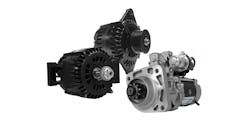“The new Explorer needed to deliver the fuel economy today's customers want, combined with the performance, capability and empowerment they expect from an SUV.” –Jim Holland, chief nameplate engineer for Ford Motor Co.’s 2011 model Explorer sport utility vehicle
Interwoven amid all the hype and hoopla surrounding the roll-out of Ford Motor Co.’s new 2011 Explorer sport utility vehicle (SUV) , there’s an interesting vehicle engineering question being asked: how does one improve the fuel efficiency of larger vehicles without sacrificing performance?
Ford, for one, is trying to do this with smaller yet more powerful engines plus wider use of lighter materials, such as aluminum – a road many other OEMs are traveling as well.
First, let’s look at the powertrain. Ford’s using as a base engine in the 2011 Explorer an EcoBoost 2.0-liter I-4 engine that uses direct injection of gasoline and turbocharging to produce 237 horsepower at 5,500 rpm, along with 250 lb.-ft. of torque. In effect, that’s marrying the power of a six-cylinder engine with the lighter displacement and fuel-sipping profile of a four-cylinder model.
This is because the peak torque in an EcoBoost is generated at a low 1,700 rpm across a broad band to 4,000 rpm, making for flexible, efficient power delivery across a wide range of engine and vehicle speeds, while helping save fuel by making power at lower rpm levels.
Now, Ford says that 2011 Explorers equipped with EcoBoost engines should get 30% better fuel economy than the 2010 models – and if I’ve done my miles per gallon (mpg) math correctly, the 2011 Explorer about 18.2 mpg in the city and 26 mpg on the highway.
Add in these tidbits as well: The EcoBoost I-4 uses 5W30-GF4 oil to reduce friction and reduce cost of ownership, as it allows for a 10,000-mile oil change interval; targeted durability is 10 years, or 150,000 miles; the addition of an aluminum oil cooler with improved heat dissipation and cast inter-bore cooling inside the aluminum engine block – representing the initial U.S.-market application of a brick-style charge-air cooler, delivering increased thermal efficiency.
Weight reduction is the second key element in improving the new Explorer’s fuel efficiency, Ford said, as its engineers were able to reduce total vehicle weight by almost 100 pounds through the use of lighter materials such as an aluminum hood.
There’s of course a whole host of other stuff being packed into the new Explorer as well – safety systems, onboard navigation, better interior storage … the list goes on and on – but the key factor here is that vehicle engineers are trying to bring small vehicle fuel efficiency to bigger platforms without affecting performance and capability.
That’s a tough trick for any vehicle OEM these days. But it’s one they must all try and master in some shape or form.



